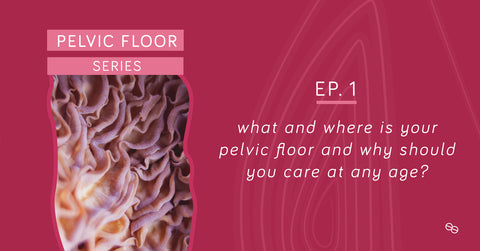What and Where is Your Pelvic Floor and Why Should You Care at Any Age?
We are not used to feeling and knowing our pelvic floor. Maybe if you have given birth or you are going through menopause, someone has told you something about your pelvic area and suggested that you take care of it.

Index:
What and where is your pelvic floor?
Which are the symptoms you might experience if your pelvic floor doesn’t work well?
Why should you care about your pelvic area?
How can you learn to feel it?
When should you do a pelvic floor evaluation?Who is entitled to make a pelvic floor evaluation or rehabilitation/training?
Take outs episode one
What's the next episode about?

You might have heard about kegel exercises though - quite a trend - which are linked to the status of your pelvic floor and have been created to help you toning it up, but that’s another story. We'll come back to kegel exercises in the following episodes when we’ll explain what pelvic floor training really is.
What and where is your pelvic floor?
Your pelvic floor is the layer of muscles that closes and holds up your abdominal area; it starts from the pubic symphysis and ends at the coccyx.
We divide it into three areas, a deeper one, a medium area and the upper one, which is closer to the vulva.
The function of your pelvic floor is to support your pelvic organs (bladder, intestine, uterus), facilitating birth movements as well as keeping your sphincters closed (both urinary and anal).
As any other muscle in your body, your pelvic floor has an optimal tone; in addition to other muscles, it moves with you. It breathes when you do. To give you an idea, think about its movement as the one of a jellyfish. It has to be flexible to work well, it contracts and relaxes. If, instead, for any reason, your pelvic floor is hypertonic or hypotonic (too contracted or too loose) it won’t work well any more.
________________________________________________________________
You may also like: Endometriosis, Pain and Sex Life
________________________________________________________________
Which are the symptoms you might experience if your pelvic floor doesn’t work well?
When the tone of the pelvic floor is not right, you can experience pain in your intimate parts, prolapse of the uterus or bladder, incontinence, recurrent vaginal infections, UTIs, difficulties during giving birth and recovery - just to mention a few symptoms.
1 in 3 women suffer from incontinence and 70% of them think it is “normal” and something you deal with but never solve. 48% of women have some sort of light prolapse and 75% will experience pain at some point in their life during penetration. A cystitis infection turns out to be chronic 40% of the time.
Let’s look at these figures; those numbers are huge. Dysfunctions of the pelvic floor are way more common than you think and, good news, most of them can be treated and you can totally recover! Problem is: almost nobody knows that.

Why should you care about your pelvic area?
So, if you are still wondering why you should care that much about your pelvic area, the answer is simple: you can prevent incurring in any of those diseases. You can learn to feel and control your pelvic floor so that you’ll be able to spot any change in advance. You’ll have more control over your body.
We tend to realise we have a pelvic floor when it hurts (like during period cramps or painful sex) or when it is under a big stress (when we are pregnant) or if we experience some sort of incontinence (spoiler: even one small drop of urine is incontince), but why nobody tells us about the existence (and importance) of our pelvic muscles when we are young?

How can you learn to feel it?
The best way to reconnect with your pelvi is to grab a mirror and have a deep look down there at your vulva. Sadly, the pelvic floor is not visible, but our vulva and the way we move it (yes, we can move our vulva) can already tell us a lot about our pelvic floor.
The idea is not to make a self diagnosis, of course, but to be aware of your own body. In this way, you’ll be able to spot any change, learn to feel your pelvic floor and to tell any specialist or doctor about it.
It is always important to connect with your sexual side to look at your intimate parts, appreciate them. Take your time, find a place where you are comfortable and you can sit with your legs opened. Take a mirror and look at your vulva’s parts.
- Are they symmetric? Which colour? Which shape? You can perhaps choose to draw your vulva so that you’ll memorize it better and you can go back to it when you like.
- Does it move? Try to make it move. Does it go in or opens?
- Touch its parts. Feel the texture, does it hurt somewhere? Are you able to feel it all or you feel less in some spots?
- When you cough does it move inside or not? Do you perhaps lose a drop of urine?

Another exercise you can try to have a better perception/awareness of your pelvic area is to roll a towel and sit on it (or you can use a pilates ball); do you feel some parts more than others? Does it hurt? Do you sit on your coccyx?
The purpose of those exercises is to have a better awareness but also to be able to tell a pelvic floor specialist how your body moves.
When should you do a pelvic floor evaluation?
As part of self care and prevention, pelvic floor checks should be included in your routine health checks. We kindly suggest every woman to do an evaluation of the pelvic floor with a specialist at least before starting any sport, before and after pregnancy and when she is about to enter menopause.
Of course, if you are experiencing any of the symptoms we mentioned above, we strongly advise to have your pelvic floor checked.
The sooner you know the status of your pelvic floor the better it is, so we suggest an evaluation even to teen girls, especially before starting any sport.
Especially if you are experiencing any sort of pain at your vulva or pelvic area or during penetrative sex or period - over 80% of Anna’s patients suffer from hypertonic pelvic floor, which results in pain - we strongly recommend you go through a pelvic floor evaluation; you can get rid of pain most of the time!

Who is entitled to make a pelvic floor evaluation or rehabilitation/training?
Each country has its own regulations, but people entitled to make evaluations and the rehabilitation are midwives, nurses, physiotherapists or gynecologists specialised into pelvic floor. Be sure those specialists have specific certifications and extensive experience with pelvic muscles!
The first evaluation should be quite a long visit (usually it lasts around 2 hours) splitted into a long chat with the patient and a physical examination. The conversation is fundamental to run a diagnosis and to give the specialist a correct vision on your intimate health and symptoms; during the physical exam all intimate parts should be checked. The evaluation should not be painful at all. If you are not comfortable with being touched in certain areas, it is your right to tell. If you are experiencing discomfort, the specialist should stop. The specialist should ask your permission before touching your body, so don’t be afraid to tell and have your pelvic floor checked.
Most countries should have pelvic floor evaluation included in the services offered by the NHS, otherwise you can try to go privately.
Take outs episode one
Your pelvic floor plays a key role in your intimate health and it is most of the time linked to symptoms like: period pain, painful sex, incontinence, pregnancy side effects, recurrent UTIs, scar pain, vaginal infections and more.

Alteration of your pelvic floor tone can result in having hyper or hypotonic pelvic muscles; most of the time, your pelvic floor can go back to normal tone and you can get rid of symptoms or conditions.
Take a mirror and look at your vulva to start connecting and feeling your pelvic floor; understand how you vulva moves.
A pelvic floor evaluation done by a specialist into pelvi treatments is recommended to all women (even your teens) at least once in a life, but mostly when you start any sport, before and after pregnancy and when you are entering menopause.
Pelvic floor evaluation and rehabilitation should be included in NHS services or you can choose to go privately; always check the doctor, midwife or physiotherapist doing your examination is specialised into pelvic floor.
What's the next episode about?
In the second episode of Pelvic Floor and Where to Find It we’ll talk about pain, going deep into why women’s pain is most of the time ignored, which kind of discomfort is linked to the pelvic floor and how you can relieve it.

